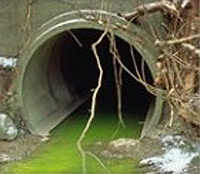 Image via WikipediaBy Charles R Brown
Image via WikipediaBy Charles R BrownIn the U.S., the future of our water supply looks bleak. There are expected to be water shortages in certain areas of the U.S. by as early as 2025 and most areas will be affected by 2050.
Despite this, we are relatively fortunate compared to the rest of the world. Not only do third-world countries lack adequate resources to keep the population hydrated, but the water is usually tainted with chemicals or contaminated. However, some developed countries even lack the proper resources and quality that one would expect. There are startling figures from the World Health Organization and Water Project that convey the ugly truth of water scarcity around the world.
Almost a fifth of the world's population lives in area that lacks enough water for the population. Almost a fourth of people in currently developing don't have the resources to divert water to the community, resulting in shortages and the need to physically find bodies of water. Most third world countries do not have bodies of water available, making communities physically unable to reach water.
One out of every three people in the world doesn't have adequate access to water resources. This number may increase to two out of five in the near future, due to increases in population and the necessity for water use in industrial and domestic use. Most people in developing countries to counter this problem by storing water in their household, but the water is not properly refrigerated and leads to contamination. This contamination usually leads to mosquito infestation, which are carriers of dengue fever, malaria and other diseases.
In certain areas where water supply is adequate, the water may be extremely contaminated and full of diseases. In developing countries, 90% of the water supplied to households and communities is not treated at all. 70% of industrial waste is released back into these water supplies, resulting in water full of chemicals and disease. In these same communities with poor water, the agricultural systems use wastewater for production, resulting in contaminated food.
Water-related diseases accounts for a staggering number of deaths and diseases. One out of every four child deaths in the world is due to a water-related disease. This accounts for 1.4 million child deaths a year, due to diarrheal complication such as cholera, typhoid fever and dysentery, and other water-borne infections. At any given time, half of the world's medical attention is given to patients suffering from water-related diseases. This should not be of any surprise, considering that in developing countries about 80% of illnesses are linked to poor water and sanitation conditions.
What can be done to improve the conditions of water worldwide? Although it is difficult to directly assist communities in obtaining healthy water, you can donate money to non-profit organizations such as the Water Project and World Health Organization. These types of organizations give donations to governments in hope of improving their infrastructure and increasing the available water supply to the communities.
Another important action is to simply spread the word. Most people are unaware of the horrible conditions of water scarcity and contamination in developing countries. By re-posting articles or telling a friend in person, more people will become cognizant of the situation and decide they need to take action as well. Improving water conditions around the world will save children from needless death and improve the quality of life for many.
Charles Brown works online through articles and forums in helping people solve their water problems. He specializes in "hard water" treatments and water contamination.
Article Source: http://EzineArticles.com/?expert=Charles_R_Brown
http://EzineArticles.com/?Water-Crisis:-A-Global-Pandemic&id=6418757

No comments:
Post a Comment